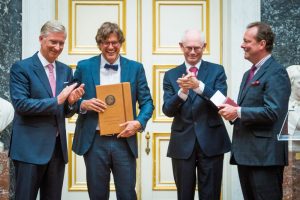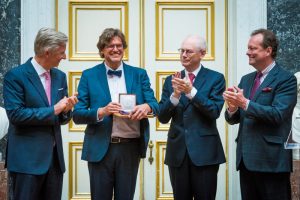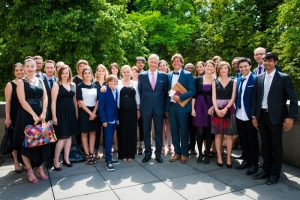2017 – Report Steven Laureys
Ceremony of the Francqui Prize
at the Fondation Universitaire June 13, 2017
Career – Work – Report of the Jury
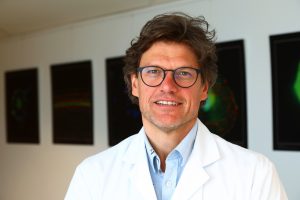
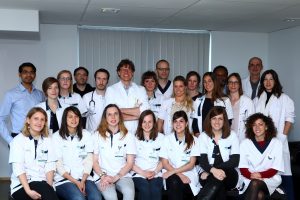
Steven Laureys
* * *
Career
Steven Laureys (°Leuven, 1968) grew up in Hoeilaart, a commune close to Brussels. The son of a garage owner and a children’s clothes seller, he dreamed of becoming a doctor from a very tender age. As a teenager, he was fascinated by the great questions of existence. Where does matter come from? How does it become alive? And especially: how can living matter develop consciousness?
Following his secondary studies at Sint-Jozef college d’Overijse, he entered the Vrije Universiteit Brussel (VUB) in 1986 to study medicine. In 1993, he did a course in South Africa in the neurosurgery department of the Stellenbosch University Hospital on the Tyberg campus in Capetown. That same year, after being awarded his degree in medicine (at VUB) with first class honours, he began his clinical training in neurology at the VUB university hospital. He was simultaneously awarded a Master’s in pharmaceutical medicine (1997).
After a spell at the University of Cambridge (1996), he began a PhD which formed the basis of his later research into comatose patients. Using PET scans and electroencephalography he studied human sleep by observing the way in which the brain reacts to the injection of radioactive water and sugar into the arteries of research subjects. His research was awarded the highest distinction by the panel (ULg, 2000). Later, Steven Laureys was also awarded a palliative care accreditation (ULB/ULg/UCL, 2004) and a higher education qualification (ULg, 2007).
Today, Professor Laureys works as a clinical professor attached to the neurology department of the Centre hospitalier universitaire du Sart-Tilman in Liege (since 2008). In addition, as head of research of the Scientific Research Fund of the French Community (FRS-FNRS), attached to the GIGA Research Centre of the University of Liege (since 2007). Steven Laureys therefore continues to combine scientific and clinical expertise, which he strongly believes is a very important combination.
Since the beginning of his career, Steven Laureys has worked to reduce the distance between different research disciplines, university faculties, care centres and language-specific communities with a view to establishing fruitful cooperation initiatives at a national and international level. It was in this context that he established the renowned international and transdisciplinary “Coma Science Group” which today has around thirty members. In collaboration with the University of Cambridge and the Weill Cornell medical centre in New York, this team is working to improve medical treatment and knowledge about impaired consciousness, such as in the case of coma, vegetative state (renamed “waking unresponsive syndrome”) by Professor Laureys, the minimally conscious state and locked-in syndrome which are the consequence of severe brain trauma. Steven Laureys founded the group « GIGA Consciousness » in Liege, an internationally recognised school which studies the pathological, pharmacological and psychological modifications in human perception and consciousness.
Because his work raises life and death issues, there has been an inevitable reaction from certain individuals with different religious and philosophical convictions. But Steven Laureys is not afraid of the social, legal, political and ethical questions raised by his work. He offered his expertise to the Pontifical Academy For science and life (2004), the American Congress (2006) and SPF public health (2006), and he met the Dalai-lama at the University of Strasbourg (2016). Since 2013, he has been ambassador for the Belgian Brain Council and a member of the Bioethics Consultative Committee (2014-2018) where, in his capacity as a neurologist and neuroscientist, he offered an informed opinion on questions relating to biology, medicine and health care.
It is not just among academic, medical and political spheres that Steven Laureys wants to draw attention to individuals affected by brain trauma. He would also like to create an awareness of the problem among the wider public. As a didactic speaker, his services are regularly solicited by the Belgian and foreign medias, and gives very respected TEDx conferences during which he argues in favour of organ donation among other things. In 2015 the publishing company Éditions Odile Jacob, published « Such a brilliant brain – The limited States of Consciousness », an accessible book focussing on the limits of our brain and its formidable capabilities.
Throughout his career, Professeur Laureys has won several awards including the William James Prize of the Association for the Scientific Study of Consciousness (2004), the Cognitive Neuroscience Society Young Investigator Award (2007) and the Blaise Pascal medal from the European Academy of Science (2012). In addition, he has been invited to occupy the role of Chaire Francqui at the university of Namur from 2014 to 2015.
Steven Laureys is married to the Canadian neuroscientist Vanessa Charland-Verville, who, like him, works at Liege University Hospital and is a member of the Coma Science Group. Together they are expecting a baby boy who will join an older sister Clara who is 18 and two older brothers Hugo and Matias who are 16 and 12 years old respectively.
* * *
Work
When, at the end of the 90s, Steven Laureys took his first steps into the world of neurology, coma research seemed to be in a comatose state itself. Fascinated from a very young age by questions relating to human consciousness, he decided to breathe new life into this research area and devote himself to the study of the brain function of patients affected by serious consciousness impairment such as coma, the vegetative state (renamed “waking unresponsive syndrome” by Professor Laureys), minimally conscious state, and locked-in syndrome. For 20 years, Professor Laureys and his team have made several discoveries. His multimodal evaluation of the consciousness of patients affected by serious brain trauma is recognized for its huge medical, scientific and ethical value.
Professeur Laureys’ research involves four aspects:
Behavioural assessment
Steven Laureys conducts clinical studies on consciousness using specific and validated clinical evaluation scales. On this basis, in 2009, his team was able to demonstrate that no less than 40% of patients in a so-called “vegetative” coma are in fact conscious (some of them to a minimal degree); a discovery with massive therapeutic, ethical and legal implications. The team also demonstrated that the best way to study eye movements was not to use an object but a moveable mirror.
Electrophysiological studies
Steven Laureys also practices electrophysiological studies using measurement of the electrical activity of the brain, by the means mentioned above and an electroencephalogram in tandem with magnetic transcranial stimulation.
Functional neuroimaging.
In addition, Professeur Laureys’ Coma Science Group uses functional neuroimaging with the aid of PET scans (a scanning technique which detects where an injected radioactive material will accumulate in the body) and MRI scans (a scanning technique based on magnetic waves). The first PET studies by Steven Laureys show that it is not overall brain activity that indicates the existence of consciousness, but rather that some areas of the brain seem more important than others for the presence of perception and thought. He also conducts in-depth studies to establish whether unresponsive patients that are in the minimally conscious state can feel pain. Based on his results, he argues in favour of giving these patients pain-killers and palliative care.
One of Steven Laureys’ greatest discoveries is unquestionably the fact that the brain contains not one but two consciousness networks – an external consciousness network (concerning the environment) and an internal one (which concerns us all). They are connected by a deep cerebral core. The brain automatically alternates between these two networks. When they no longer function, there is no more consciousness, even if the patient can still breathe and move. While it is true that this discovery has made it possible to better understand the neural network of consciousness, it has also got clinical implications: these advances are applied to gaining a better understanding the chances of a cure and testing new treatments later on.
In his research on individuals who find themselves in a minimally conscious state, Steven Laureys makes intensive use of emotional stimuli. It has been shown that seeing one’s own face in a mirror or hearing one’s favourite music, generates greater brain activity. This is known in psychology as « The cocktail party effect”: while attending a party, you can still distinguish your name among all the commotion.
In collaboration with the University of Cambridge, Professor Laureys’ team is developing a new paradigm in FMRI which tries to read the thoughts of non-communicative patients by having them complete imaginary tasks during the scan. It is possible to communicate with patients who are incapable of speaking by asking them questions where, in the case of a “yes” answer, they must think of a sport and in the case of a “no” answer, they have to think of walking toward their house. Different parts of the brain will become illuminated in accordance with the answers. His team has also conducted studies on healthy volunteers whose consciousness has been alternated by anaesthesia or hypnosis in order to better understand, based on this information, the residual brain activity of coma survivors.
Ethical aspects
Finally, as a committed humanist, Steven Laureys is interested in ethical questions and social issues raised by patients in a coma or in similar conditions. For this reason, he launched a European initiative to replace the term “vegetative”, which has a negative connotation, by the more neutral and descriptive term “waking unresponsive syndrome”. He is also involved in the debate on the end of life after coma, in the hope of rationalising it by means of scientifically substantiated data. But above all, he has shown himself to be a fervent and charismatic defender of the right to a better quality of life and better adapted care for patients affected by brain trauma and chronic consciousness impairment.
* * *
Report of the Jury (May 2, 2017)
The 2017 Francqui Prize in Biological and Medical Sciences is awarded to Steven Laureys for his seminal contributions to our understanding and diagnosis of disorders of consciousness. The medical community has long recognized the ability of severe traumatic brain injury to produce a form of chronic coma state characterized by a lack of awareness or responsiveness – traditionally referred to as a “vegetative state”. Affected individuals were generally thought to have an extremely poor prognosis and to be without any level of conscious perception.
Through an elegant line of inquiry leveraging a range of behavioral, electrophysiological, neuroimaging and neuromodulation approaches, Dr.Laureys’ work has directly led to the realization that as many as 40% of individuals in a vegetative state actually do retain some level of consciousness. Some of these individuals appear to perceive pain, forcing a greater consideration of the administration of analgesics during interventions. Perhaps most important, while some of these individuals demonstrate no behavioral signs of conscious awareness, his neuroimaging work shows that they are in fact able to modulate brain activity in response to instructions.These findings have tremendous implications for our understanding and clinical management of disorders of consciousness, and have resulted in changes in both the nomenclature and diagnosis for this domain of neurological illness. Equally important, his work has informed our thinking regarding ethical and legal issues surrounding the rights of affected individuals and legal decision-making regarding their chronic treatment and end-of-life issues.
Most recently, Dr. Laureys and his collaborators have begun to evaluate novel strategies for the treatment of disorders of consciousness. A range of pharmacological and transcranial stimulation approaches are being tested, with initial results suggesting an ability to improve awareness in affected individuals.
Collectively, Dr. Laureys’ work has transformed our understanding of disorders of consciousness, and substantially improved their diagnosis and management.
Members of the Internatonal jury :
Professor Dr. J.C. Hans Clevers, MD PhD
Hans Clevers is Professor of Molecular Genetics at the Utrecht University, director Research of the Princess Maxima Center for pediatric oncology since June 1, 2015 and past-President of the Royal Netherlands Academy of Arts and Sciences. He is the recipient of several awards. He is member of the Royal Netherlands Academy of Arts and Sciences (2000), of the American Academy of Arts and Sciences (2012), of the National Academy of Sciences of the USA (2014), of the Academie des Sciences (2017) and of the Orden Pour le Mérite für Wissenschaften und Künste (2017). He is Chevalier de la Legion d’Honneur since 2005, and Knight in the Order of the Netherlands Lion since 2012.
Chairman
and
Professor Michael F. Clarke MD
Michael F. Clarke, MD is a Professor of Medicine and Stanford University. He is the Karel and Avice Beekhuis Professor in Cancer Biology and the Associate Director, Stanford Institute for Stem Cell Biology and Regenerative Medicine.
Dr. Clarke was the first to isolate and characterize cancer stem cells from solid cancers including breast cancer and has identified critical regulators of normal and cancer stem cell functions. These discoveries have implications for the treatment of both cancer and degenerative diseases. Recent findings have led to new treatment algorithms that will result in increased survival of patients with early stage colon cancer.
Professor Dr. Kurt Konhauser
Kurt O. Konhauser is a Professor of Geomicrobiology at the University of Alberta. He is Editor-in-Chief for the journal Geobiology, and author of the textbook Introduction to Geomicrobiology. His research focuses on the role of microbes in metal binding and forming minerals to describing the biogeochemical processes controlling elemental cycling in oceans through time.
Professor Dr. Michael P. Milham MD PhD
Dr. Milham is the Phyllis Green and Randolph Cowen Scholar and the Founding Director of the Center for the Developing Brain at the Child Mind Institute in New York; He is also the Director of the Center for Biomedical Imaging and Neuromodulation at the Nathan S. Kline Institute for Psychiatric Research. Dr. Milham has expertise in cognitive neuroscience, brain imaging, open science and psychiatry. His work has led him to be identified as one of Thomson Reuters Highly Cited Researchers (top 1 percent) for Neuroscience and Behavior in each of the past three years (2014-2016).
Professor Sir Peter Ratcliffe MD – Nobel Prize 2019 Medicine
Originally a nephrologist, Peter Ratcliffe became fascinated by the mechanism by which kidneys regulate erythropoietin in accordance with blood oxygen carrying capacity, and in 1989 founded the Oxford Hypoxia Biology Laboratory. The work led to the discovery and elucidation of mechanisms of oxygen sensing in human and animal cells that control a wide range of cellular and systemic responses to hypoxia. From 2004 – 2016 Professor Ratcliffe held the Nuffield Chair of Clinical Medicine in Oxford University. He is currently Director of Clinical Research at the Francis Crick Institute, London and Director of the Target Discovery Institute at the University of Oxford. He was knighted for services to clinical medicine in 2014 and has won many awards for his work on oxygen sensing mechanisms, including the 2016 Lasker Award for Basic Biomedical Science.
Professor David A. Relman, MD
David A. Relman, M.D., is the Thomas C. and Joan M. Merigan Professor in the Departments of Medicine, and of Microbiology and Immunology at Stanford University, and Chief of Infectious Diseases at the Veterans Affairs Palo Alto Health Care System in Palo Alto, California. He is also Co-Director of the Center for International Security and Cooperation and Senior Fellow at the Freeman Spogli Institute for International Studies at Stanford University.
Professor Dr. Roland J. Siezen
Professor Roland Siezen received his PhD in biochemistry from the University of Groningen, the Netherlands, and was a postdoctoral fellow at Scripps Institution of Oceanography, La Jolla (1974-1975), University of Nijmegen (1975-1977), Australian National University, Canberra (1977-1983), and MIT, Cambridge (1983-1986). He was then head of various departments at NIZO food research, the Netherlands (1986-2000) before becoming Professor of Bacterial Genomics at Radboud University, Nijmegen. His research focused on bioinformatics and comparative genomics of bacteria. In 2011 he founded the start-up Microbial Bioinformatics, providing similar services to industrial partners.
Professor Charles Swanton MD PhD FRCP FMedSci
Professeur Charles Swanton completed his MDPhD in 1999 at the Imperial Cancer Research Fund Laboratories and Cancer Research UK clinician/scientist medical oncology training in 2008. Charles combines his laboratory research at the Francis Crick Institute with clinical duties focussed on biological mechanisms of cancer drug resistance. Charles was made Fellow of the Royal College of Physicians in April 2011 and Chair in Personalised Cancer Medicine and Consultant Thoracic Medical Oncologist at UCL Hospitals in November 2011. Charles is the Chief Investigator of the CRUCK TRACERx lung cancer evolution study and was awarded the Royal College of Physicians Goulstonian lecture and Graham Bull Prize for Clinical Sciences in 2013, Fellow of the European Academy of Cancer sciences in 2013, and Fellow of the Academy of Medical Sciences in 2015. Charles was awarded the Jeremy Jass Prize (2014) , Stand up to Cancer Translation Cancer Research Prize (2015), Glaxo Smithkline Biochemical Society Prize in recognition of distinguished research leading to new advances in medical science and the Ellison-Cliffe Medal and Lecture, Royal Society of Medicine (2016). Charles was appointed Napier Professor in Cancer by the Royal Society in 2016.
Professor Alec Vahanian Poghossian MD
Alec Vahanian studied medicine at University Paris VI becoming a Doctor of medicine in 1972. He became a Professor of Cardiology in 1988 and was made head of the cardiology department at Tenon Hospital then Bichat hospital Paris since 1994. His special research interests are in valvular heart disease and interventional cardiology. He is a member of the Board of the European Society of Cardiology, Chairman of the European Observational Registry Programme .He was chairman of the 2007 and 2012 ESC/EACTS Task Force and Valvular Heart Disease. He is also a member of the French Society of Cardiology and former President of the French Federation of Cardiology. Alec Vahanian is associate editor of the European Heart Journal and EuroIntervention. He is the author of over 400 articles in peer-reviewed journals and has given over 600 invited lectures at National & International congresses.
Professor Fiona M. Watt FRS FMedSci
Professor Fiona Watt obtained her first degree from Cambridge University and her DPhil, in cell biology, from the University of Oxford. She was a postdoc at MIT, where she first began studying differentiation and tissue organisation in mammalian epidermis. She established her first research group at the Kennedy Institute for Rheumatology and then spent 20 years at the CRUK London Research Institute (now part of the Francis Crick Institute). She helped to establish the CRUK Cambridge Research Institute and the Wellcome Trust Centre for Stem Cell Research and in 2012 she moved to King’s College London to found the Centre for Stem Cells and Regenerative Medicine.
Members
* * *
